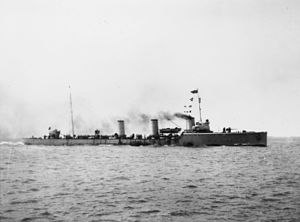G101-class torpedo boat
 A G101-class destroyer underway circa 1916
| |
| Class overview | |
|---|---|
| Builders | Germaniawerft, Kiel |
| Operators | |
| Built | 1912–1915 |
| In commission | 1915–1918 |
| Completed | 4 |
| Lost | 4 |
| General characteristics | |
| Type | Destroyer |
| Displacement | 1,734 t (1,707 long tons) deep load |
| Length | 95.3 m (312 ft 8 in) oa |
| Beam | 9.47 m (31 ft 1 in) |
| Draught | 3.84 m (12 ft 7 in) |
| Installed power | 28,000 PS (28,000 shp; 21,000 kW) |
| Propulsion |
|
| Speed | 33.5 knots (62.0 km/h; 38.6 mph) |
| Range | 2,420 nmi (4,480 km; 2,780 mi) at 20 knots (37 km/h; 23 mph) |
| Complement | 104 |
| Armament |
|
The G101 class was a class of four large
Design
In 1910, the
The four new ships were 95.3 metres (312 ft 8 in)
The Argentines planned to arm the ships with four 4-inch (102 mm) guns supplied by the American
Ships
| Vessel[c][d] | Launched[2] | Completed[2] | Fate |
|---|---|---|---|
| SMS G101 | 12 August 1914 | 4 March 1915 | ex Santiago; Interned, Scapa Flow, 22 November 1918; scuttled 21 June 1919. |
| SMS G102 | 16 September 1914 | 8 April 1915 | ex San Luis; Interned, Scapa Flow, 22 November 1918; beached while attempting to scuttle, 21 Jun 1919; to United States, 1920; sunk as aircraft target, 13 July 1921 off Cape Henry .
|
| SMS G103 | 14 November 1914 | 15 May 1915 | ex Santa Fé; Interned, Scapa Flow, 22 November 1918; scuttled 21 June 1919. |
| SMS G104 | 28 November 1914 | 5 June 1915 | ex Tucuman; Interned, Scapa Flow, 22 November 1918; scuttled 21 June 1919 |
Service
The four ships were all completed in 1915, forming the 2nd Torpedo Boat Flotilla along with the other large torpedo boats of the B 97 class.[2][9] The G102s were slower than the B97s and as a result often operated separately.[10] While they were officially designated as torpedo boats, as the G102 class and B97 class were significantly larger than the existing torpedo craft of the German Navy, they were known as destroyers (Zerstörer) rather than torpedo boats.[6] All four ships were present at the Battle of Jutland.[11] Three ships of the class took part in the destruction of a convoy running between Norway and England on 11 December 1917.[12]
All four ships of the class survived the war and were interned at Scapa Flow, along with most of the rest of the
Notes
- ^ SK stands for Schnellfeuerkanone – Quick firing cannon in German
- ^ L/45 refers to the length of the gun's barrel. In this case the barrel was 45 calibres long.
- Seiner Majestät Schiff", or "His Majesty's Ship" in German.
- ^ The prefix letter on German torpedo craft indicated the ship's builder. G= Germaniawerft.[8]
Citations
- ^ Gardiner & Gray 1985, pp. 400, 402
- ^ a b c d e f g h Gröner 1983, p. 62
- ^ Gardiner & Gray 1985, p. 402
- ^ a b Gardiner & Gray 1985, p. 170
- ^ a b Gardiner & Gray 1985, pp. 169–170
- ^ "German Destroyers & Torpedo Boats WW1". www.naval-history.net. Retrieved 2016-12-23.
- ^ Gardiner & Gray 1985, p. 164
- ^ Ruge 1972, p. 53
- ^ Campbell 1998, p. 27
- ^ Campbell 1998, p. 25
- ^ Ruge 1972, p. 66
- ^ Gröner 1983, pp. 54, 62
References
- Campbell, John (1998). Jutland: An Analysis of the Fighting. London: Conway Maritime Press. ISBN 0-85177-750-3.
- Gardiner, Robert; Gray, Randal, eds. (1985). Conway's All The World's Fighting Ships 1906–1921. London: Conway Maritime Press. ISBN 0-85177-245-5.
- Gröner, Erich (1983). Die deutschen Kriegsschiffe 1815–1945: Band 2: Torpedoboote, Zerstörer, Schnelleboote, Minensuchboote, Minenräumboote. Koblenz, Germany: Bernard & Graefe Verlag. ISBN 3-7637-4801-6.
- Ruge, F. (1972). Warship Profile 27: SM Torpedo Boat B110. Profile Publications.
Further reading
- Moore, John, ed. (1990). Jane's Fighting Ships of World War I. London: Studio. ISBN 1-85170-378-0.
